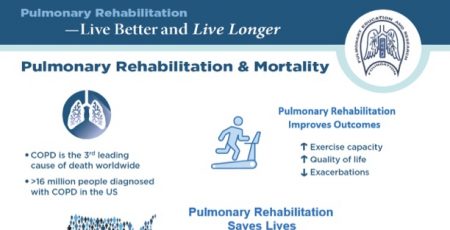01 Jun Preventing Panic When Short Of Breath
By Mary Burns, RN, BS
Asst. Clinical Professor, School of Nursing, UCLA (ret)
Executive Vice President, PERF
THE IMPORTANCE OF PROPER BREATHING TECHNIQUES FOR THOSE WITH COPD
Do you ever get so short of breath that you panic? It is instinctive for everyone to breathe faster and harder to relieve shortness of breath. Did you know this is the worst thing you can do if you have COPD (chronic obstructive pulmonary disease)? What you really should do is the exact opposite! To breathe easier you need to slow your respiratory rate, forget about breathing in and just concentrate on breathing out! Yes, this is counterintuitive. After you have read the information in this article you will understand why this will help you and why certain breathing techniques can relieve shortness of breath, increase the oxygen saturation in your blood and prevent panic. If you are interested in this explanation, or in learning other techniques that will help you enjoy a life free of the fear of shortness of breath or panic, keep reading.
Over and over patients graduating from pulmonary rehabilitation classes have said breathing retraining is the most important thing learned in class. Once they had control over their breathing they were able to start exercising and learning all those other things offered. Who can think of exercise when they get short of breath walking across the room?
Of course, you have already discussed your shortness of breath with your physician. He (or she) probably has tested you for the various problems that can cause shortness of breath including heart disease, anemia, extreme obesity, asthma, and various types of respiratory conditions as well as pregnancy, but we won’t go into that at this time. Maybe you are using prescriptions for medications or inhalers for COPD, and you’ve been tested for the need for supplemental oxygen.
If you have a respiratory problem, your doctor may suggest a pulmonary rehabilitation class if there is one in the area. Such a class helps you learn efficient breathing techniques such as proper PLB (pursed lips breathing). What if you don’t have a pulmonary rehabilitation program nearby to help you? It probably is a little harder to learn those techniques without a therapist to help, but it still can be done.
If you have been diagnosed with COPD and are taking all the medications, or even oxygen, as prescribed by your doctor, why are you still having sudden attacks of extreme shortness of breath or even panic? How do you handle that, and what causes it? Let’s start with a few basics.
Many of you may feel that you “suddenly” developed a problem with your breathing after getting that last episode of flu or pneumonia. Actually, emphysema is a disease that slowly progresses over a 20- or 30-year period. The first thing that happens, maybe while you are still a teenage smoker, is that the elastic fibers in your lungs start to deteriorate and lungs start losing their elastic recoil, that is, their ability to get air out of the lungs efficiently. Over the years this gets worse so you start to develop air trapping in your lungs.
Everybody has some air in their lungs, even after they breathe out as much as they can. This is normal and prevents the alveoli, the little air sacks, from collapsing flat as an old balloon. Patients with COPD may have a 200% or even larger increase in air trapping, known as residual volume, in their lungs. Why does that matter? That amount of extra air can compress some of the undamaged alveoli, so that they can’t work efficiently, much the way an expanded air bag would compress your body in your car seat. The other thing that happens is that those larger lungs push out your chest wall. Have you noticed that your chest size is larger, or that your bra size has increased?
Another effect of air trapping is that the upward curve of the diaphragm becomes flattened, which can be seen on your chest x-ray. When your lungs weren’t damaged, the diaphragm did about 80% of the work of breathing. Now its ability to suck in air as it tightens and flattens is limited, because it is already flattened out to make room for that extra lung volume. The mechanics of breathing are all thrown off. You start to use accessory muscles of respiration such as your shoulder and neck muscles. These muscles are only meant for use in emergencies. They are inefficient. If you think that you work harder on your breathing than other people do, you are absolutely right. Even at rest you are probably working many times harder to breathe than a person without lung disease.
What can you do about that? You can learn a more efficient way of breathing! You have been breathing ever since you entered this world so why are you suddenly supposed to learn a new way to breathe? Because there have been changes in your body. If you remember what is wrong, it will be easier to make sense of the new breathing techniques you will learn. That loss of elasticity in your lungs is the first thing for you to remember. In practical terms it means you now have to work to get air out of you lungs. Think of a balloon. You work to get air into a balloon but when you let go of the neck of the balloon, the elastic recoil shoots the air out of the balloon without any effort on your part. Your lungs do the same thing, when they are not damaged. However, if they lose their elastic recoil you have to now work to get the air out. It’s like breathing air into a paper bag. You have to squeeze the air out of the bag since it won’t flatten out by itself. Now you also have to work to get air out of your lungs so you can make room for the oxygen in the fresh air you need.
Forget about breathing in which is automatic and not your problem. Your problem now is getting air out of your lungs to make room for the air you need to breathe in. When you have COPD you may need to breathe out 2 or 3 times longer than you breathe in to accomplish that. If you panic and breathe too fast, or even if you breathe in and out at the same rate, you will cause more air trapping, leave less room for fresh air, and quickly get more short of breath. The other very important thing you need to do is slow down. Pace yourself! Walk across the room slowly instead of running to get across it before you get short of breath!
What about this PLB, pursed lips breathing, we keep talking about. Does it really help? Yes, it does! Correctly done, PLB can raise the oxygen level of your blood as much, and faster, than being put on 2 liters per minute of oxygen. We have demonstrated that in test after test. Then why do some of you not feel much better when you use PLB? Why do you sometimes feel worse? Because you may not be doing it correctly! Done correctly, you breathe in deeply and slowly through your nose. You slowly breathe out about 3 times longer through slightly pursed lips with just a small opening in the center of your lips. Think in terms of gently blowing out hard enough to make a flame flicker, but not hard enough to blow out a birthday candle! Remember, it is very important to slow down your breathing and concentrate on breathing out. Pursing your lips is one of the techniques that helps.
Always remember, one of the biggest mistakes made is blowing out too forcefully. If you use too much force you can actually LOWER the oxygen level of your blood and make yourself become more short of breath! If you can be heard breathing out, you are working at this too hard! If you feel light headed, or uncomfortable doing PLB, you are also working too hard. Stop and rest a bit. Good PLB feels comfortable and natural. Another common mistake is gulping a little air in through the mouth before breathing out, or while trying to breathe out.
Using an oximeter is one of the easiest ways of telling if you are doing effective PLB. Borrow one to try if you can. If your oxygen level is low, say 88%, with good PLB you can usually “blow the number up” to 93%. Practiced breathers can sometimes get their saturation all the way up to 98% but 93% or 94% are good numbers to aim for. What happens if you breathe incorrectly? Maybe nothing, except that you don’t feel less short of breath and may even feel worse. With the oximeter you will see for yourself that your oxygen saturation levels will drop, and continue to drop, until you stop blowing out so hard.
What about those who suffer from a restrictive pulmonary disease such as IPF, idiopathic pulmonary fibrosis? Do these breathing techniques work for them also? Yes, a variation of PLB can help. There are many kinds of restrictive disease. Each patient is different and needs to experiment more with breathing techniques than someone with COPD. Doing so with the aid of an oximeter makes it much easier to learn the best way of breathing.
Patients with COPD will slow their breathing rate down to 10 or 12 breaths a minute to control panic. Patients with IPF who breathe very rapidly when they panic can rarely slow their breathing down to less than 16 breathes a minute. Since they do not have air trapping this is adequate. Again, PLB helps accomplish this. Always pacing themselves is even more important for those with IPF than for those with COPD. Just getting out of a chair too quickly can precipitate a drop in oxygen saturation levels and cause a marked increase in shortness of breath. Again, while pacing is important for all respiratory patients, it is essential for those with restrictive disease! This cannot be stressed often enough.
We hope you have been helped with some of these basic techniques needed to help control shortness of breath and prevent panic. There are many other factors, such altitude and exercise, that also affect breathing but space is limited and we’ll cover them another time. Let us know if these or other topics are of interest by entering them in the comment area at the bottom of this blog post. Helping you is our goal! We do care.
Best wishes and better breathing to all,
Mary





C M Szerlip
Posted at 14:09h, 02 JuneGood to know. I’m sleep apnea, not COPD, but this sounds very sensible and applicable. I’m one of Cris Brust’s from Harbor City long, long ago, and have kind of slid sideways into perf,
PATRICIA KENZIC,
Posted at 18:11h, 03 JuneVery Informative Indeed,and a Great Help to me,I am not up how to do email.Thankyou .
Verneda McBroom
Posted at 01:34h, 01 JulyI need to learn thi, I panic almost every time I get short of breath especially if I am out walking and not close to home in real cold ,hot or windy weather. It is so scary that I do not walk in these conditions unless I have no choice.
PERF
Posted at 14:15h, 05 JulyWe are sorry to hear this, Verneda, and we hope that these tips may help you.
Pingback:PERF Monthly Newsletter - June 2017 | PERF 2nd Wind Blog
Posted at 13:45h, 05 July[…] …Read more […]
Heidi McCray
Posted at 19:48h, 06 AugustThis was very informative. I have COPD and June 6,2017 I went from bad to worse in 20 minutes. I got to the point I had to call EMS as I was alone and breathing very heavy, became light headed. But I kept doing PLB. In the ambulance they had to give me 120 liters of oxygen , 1 1/2 albuterol treatments. The ER gave me another albuterol treatment, an IV of Thorazine.(about 10 min from arriving to ER I developed hiccups with every breath from my diaphram. It didn’t hurt but was annoying). They did blood tests, chest X-ray and the dreaded Blood Gas Test. Gave me 50 mg of Prednisone and sent me home after 6 hours with prescription for Prednisone 5 day supply with first dose 50mg tapering down to 10 mg. I have been doing online research about COPD . July 6,2017 ANA and other blood tests confirm I also now have LUPUS. Do you publish information on that also? I believe in being proactive in all my health care. I research, question my doctor, excercise, stick to medicine routine. I get very fatigued easily. Lots of rib to rib pain, back pain and chest pain, red rash on cheeks, forehead, chest and back of neck . I itch a lot including my scalp. The LUPUS part is new to me so researching. The COPD was discovered Feb 2017 after having pneumonia in Sept and October. But the coughing and short breath and all that is part of COPD lasted from Sept to the 2nd week of Feb. please let me know information you might publish regarding LUPUS itself or in conjunction with COPD. Thank you for the newsletter it is a great aide.
PERF
Posted at 18:12h, 07 AugustDear Heidi – We are sorry to hear of all that you’ve been through, but we’re glad that you’re seeking medical help when it is needed – and also that you were able to use Pursed-Lip Breathing to help you through your crisis until the ambulance arrived. Unfortunately, we do not write articles about lupus. You might consult the National Resource Center on Lupus, a website by the Lupus Foundation of America.
Heidi McCray
Posted at 22:12h, 07 AugustThank you for the Lupus link. I will check it out. Will keep looking on PERF for information on my COPD. Great newsletter and informative tools I can use. Keep the articles coming!
PERF
Posted at 06:32h, 16 AugustThank you, Heidi – We certainly will!